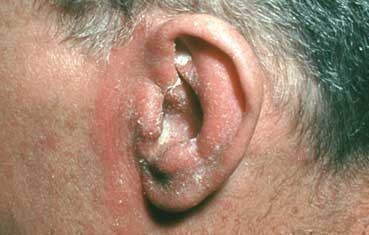
Seborrheic dermatitis: Despite its appearance, this skin disease is not caused by poor hygiene.
This is a very common skin disease that causes a rash. When this rash appears, it often looks like the one pictured above. The skin tends to have a:
- Reddish color.
- Swollen and greasy appearance.
- White or yellowish crusty scale on the surface.
One or more of these rashes can appear on the body. Sometimes, the affected skin itches.
Seborrheic dermatitis can look like psoriasis, eczema, or a skin allergy.
Cradle cap: A type of seborrheic dermatitis
Many infants get cradle cap. This is a type of seborrheic dermatitis (seb-uh-ree-ick dur-muh-tahy-tis) that develops in babies. Scaly, greasy patches form on the baby’s scalp. The patches can become thick and crusty, but cradle cap is harmless. Cradle cap usually goes away on its own within a few months.
Babies also get seborrheic dermatitis in their diaper area and elsewhere. In the diaper area, the red rash often is mistaken for diaper rash. A few babies get seborrheic dermatitis that covers much of the body with red, scaly patches.
No matter where the seborrheic dermatitis forms, it tends to permanently disappear between 6 months and 1 year of age.
Seborrheic dermatitis is long-lasting in adults
When an adult gets seborrheic dermatitis, the condition can come and go for the rest of the person’s life. Flare-ups are common when the weather turns cold and dry. Stress also can trigger a flare-up. The good news is that treatment can reduce flare-ups and bring relief.
Seborrheic dermatitis: Diagnosis, treatment and outcome
Seborrheic dermatitis is a condition that dermatologists frequently diagnose and treat.
If you think you might have seborrheic dermatitis, you should see a dermatologist for a diagnosis. This common skin condition can look like psoriasis, eczema, or an allergic reaction. Each of these skin diseases requires different treatment.
Diagnosis
A dermatologist diagnoses seborrheic dermatitis by:
- Reviewing the patient’s medical history.
- Examining the patient’s skin and looking closely at the rash.
Sometimes seborrheic dermatitis is a sign of an underlying medical condition. If your dermatologist suspects this, medical tests may be necessary.
Treatment
Although treatment cannot cure seborrheic dermatitis, treatment has benefits. Treatment can loosen and remove scale, prevent a skin infection, and reduce swelling and itch.
The type of treatment a dermatologist prescribes varies with age and where the seborrheic dermatitis appears on the skin.
Infants (scalp): Called cradle cap, this tends to completely disappear without treatment. If treatment is necessary, a dermatologist may recommend:
- Shampooing the baby’s scalp daily with a baby shampoo.
- Gently brushing away the scale, once scale starts to soften.
- Applying a medication to the infant’s scalp.
Infants (skin beyond the scalp): This, too, will clear. If treatment is needed, a dermatologist may prescribe a medicine that can be applied to the child’s skin.
Adolescents and adults (scalp and rest of body): After infancy, seborrheic dermatitis usually does not go away without treatment. For the best results, a dermatologist will consider many factors before creating a treatment plan. Treatment may include:
- Dandruff shampoos.
- Medicine to apply to the skin for short periods of time.
- Barrier-repair cream.
Dandruff shampoos can be helpful on the skin as well as the scalp. Your dermatologist can explain how to use these shampoos on the skin.
Often the best results come from combining two or more treatments. Your dermatologist can create a treatment plan to meet your needs. Most plans include medication and skin care.
Always follow your dermatologist’s instructions. Using a treatment more often than prescribed or longer than prescribed can cause side effects.
Outcome
Infant: Seborrheic dermatitis often completely disappears by 6 months to 1 year of age. It can return when the child reaches puberty.
Adolescent or adult: A few people see seborrheic dermatitis clear without treatment. More often, seborrheic dermatitis lasts for years. It tends to clear and flare without warning. Treatment often is necessary to control it.



